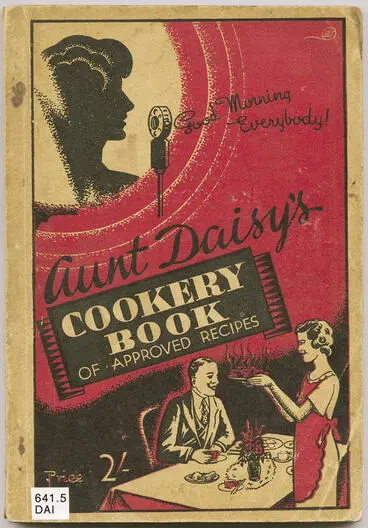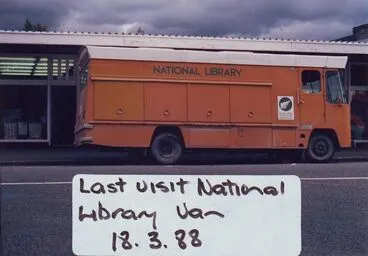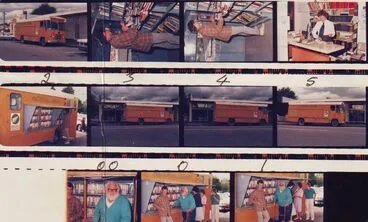Country Library Service - Mobile Books!
A DigitalNZ Story by Zokoroa
This story gives a snapshot history of the Country Library Service and its bookvan and loans services, sprinkled with some anecdotal memories about the National Library Hamilton Regional Centre.
Country Library Service, National Library, School Library Services, Libraries, Bookvans, Library van, Bookmobiles, Librarians, Books, Hamilton
Memory Lane
Do you remember the days when the bookvans from the Country Library Service / National Library would visit your local community? Maybe you were one of the Field Librarians that drove vanloads of books, bringing joy to regional outskirts. Or one of the 'behind the scenes' team at the regional offices in Hamilton, Palmerston North and Christchurch or head office at Wellington. This story gives a snapshot history, sprinkled with some anecdotal memories about the National Library's former Hamilton Regional Centre.
The Country Library Service began operating in 1938 & became part of the National Library's Extension Division in 1965
Following local body government amalgamation, the bookvans from Hamilton, Palmerston North & Christchurch ceased in 1988
Alexander Turnbull Library
1955: Country Library Service bookvan visiting Kawerau.
Unidentified woman with the Country Library Service van, Kawerau
Alexander Turnbull Library
1969: Choosing books in Wellington.
Country Library Service bookvan
Archives New Zealand Te Rua Mahara o te Kāwanatanga
1988: 'Newer' model of bookvan at Shannon Library, which operated from the Palmerston North regional centre (PCL / PN).
Dylan Owen (field librarian) with National Library van outside Shannon Library, 1988
Kete Horowhenua
1. In a nutshell: 1938 - 1988
This story commemorates the fifty year journey of the Country Library Service (CLS) and its bookvans which began in 1938 and evolved into becoming part of the National Library of New Zealand's Extension Division in 1965. Following the amalgamation of local body government, the bookvans ceased operation in 1988. Field Librarians would load up their bookvans from the 'Adult' collection at the regional centres in Hamilton, Palmerston North and Christchurch, which also housed part of the 'Schools' collection (School Library Service - SLS). Then they'd set off for days on end visiting small rural libraries, prisons, mental health hospitals, forestry camps and military bases to exchange loans.
1958: Selecting books off the bookvan.
Country Library Service.
Auckland War Memorial Museum Tāmaki Paenga Hira
1972: Choosing books at Rāhotu, Taranaki.
Country Library Service van
Manatū Taonga, the Ministry for Culture and Heritage
June 1972: Bookvan at Ngapaenga in the Waitomo District.
Child photographed against shelves of books
Alexander Turnbull Library
2. INITIAL concept of TRAVELLING LIBRARies
The Munn-Barr report (1934) on New Zealand libraries identified the need for a planned and integrated national library system. It also noted the following about the Workers' Education Association: "The Canterbury branch operates a bookmobile, or travelling library, which carries book supplies throughout its territory. This is an interesting experiment in rural library service which may provide valuable data in connection with a more general library service to country residents." (p.47)
Munn-Barr report (1934) recommended a National Library be established
The report by Ralph Munn and John Barr noted the WEA travelling library initiative.
Manatū Taonga, the Ministry for Culture and Heritage
In 1925, Prof James Shelley (Univ of Canterbury) started WEA Box Scheme
Workers' Education Association groups received a box with study notes, gramophone records & books on literature & arts.
Victoria University of Wellington
Each WEA study group of up to 20 people retained the box for a week
After a week, the box was forwarded on to the next group, until the box circulated to 7 groups.
Alexander Turnbull Library
In 1929, Shelley proposed a tutor & a car travelling library for WEA study groups
Funding was granted by Carnegie Corporation of New York (1929) & a 1926 Ford Van fitted out with new books
Alexander Turnbull Library
Travelling library operated with Geoffrey Alley (one of Shelley's BA students) as tutor/driver (1930-1933)
University of Canterbury Library
Florence Polson, the President of the Women's Division of the Farmer's Union, had also started a book club at Marton in 1927. Parcels - two books, magazines and children’s books - were carried for free to subscribing members by NZ Railways. (See: Nancy Swarbrick, 'Rural services - Getting news and information', Te Ara - the Encyclopedia of New Zealand, http://www.TeAra.govt.nz/en/rural-services/page-6 )
3. BegiNnings of Country Library Service (CLS): 1938
In October 1935, the Government issued 'The Government's National Library Service' (Memorandum no. 34). The four-page statement began by saying: "It is the Government's intention to organise a National Library Service with a view to assisting small country libraries and to provide facilities for districts which have no libraries." Initially a national central lending library was to be set up. At a later stage, a number of regional depository libraries would be established which would operate travelling libraries as part of their service. "Details of this ultimate stage are being worked out," the Memorandum said.
30 May 1938: Official inauguration of CLS with PM Michael Joseph Savage, Cabinet members & library community members.
Official inauguration of the New Zealand Country Library Service
Alexander Turnbull Library
The outcome was that the Country Library Service began in 1938 with Geoffrey Alley appointed as its Head Librarian / Director. Bookvans were sent from Wellington to small-town libraries and isolated rural areas where people had set up a lending library in their home for the locals to access.
Minister of Education Peter Fraser set up the Country Library Service (CLS).
Peter Fraser, Minister of Education when the Country Library Service was established. S.P. Andrew Collection, Alexander Turnbull Library, F-20106-1...
Victoria University of Wellington
Geoffrey Alley who was involved with setting up a WEA van service in Canterbury was appointed as the head of CLS.
Geoffrey T. Alley, Officer in Charge — and Director Country Library Service 1937-1945, — Director National Library Service 1945-1964, — National Li...
Victoria University of Wellington
4. Getting underway with rural libraries, Military camps & Lighthouses
The service began with two book vans which were built in the Government Railway Workshops. (NZL, v.1, June 1938, p.81.) "By the end of 1938 the book vans were visiting 16 public libraries controlled by borough councils or town boards which had agreed to provide free service to residents (the 'A' service), and 179 small independent subscription libraries in county areas which paid a small fee and agreed to open their doors to all residents (the 'B' service). In addition, provision was made for the supply of books by hamper to small isolated groups ('C' service) and by post to isolated individuals ('D' service)." (AJHR, 1939, H-32A, pp.1-2. cited by W.J. McEldowney, Geoffrey Alley, Librarian, p. 102)
Dec 1938: Van parked at temporary headquarters of the service at Parliament Buildings
Evening Post" Photo. Excellent progress has been made by the recently instituted country library service operated by the Government. The picture to...
National Library of New Zealand
Library staff appointed
RURAL LIBRARIES (Evening Post, 02 February 1938)
National Library of New Zealand
See Te Ara's history of the Country Library Service.
The National Library
Manatū Taonga, the Ministry for Culture and Heritage
An account of Alley's life (1903-1986) & creation of the Country Library Service, written by W. J. McEldowney, 2006.
Chapter 7 — Anni Mirabiles: Country Library Service - Geoffrey Alley, Librarian: His Life & Work
Victoria University of Wellington
1940: Country Library Service staff photo.
Country Library Service staff in 1940. H.J. Lorimer, G.T. Alley, W.A. Lindsay, J.W. Rawson, J.S. Wright, and J. Lawrence. In front: R. Fogo and N. ...
Victoria University of Wellington
Military camps and airforce bases received loans of books.
Trentham Military Camp
Alexander Turnbull Library
Hokianga Country Library Service
Museum of New Zealand Te Papa Tongarewa
Vivienne Lee-Johnson, Hokianga
Museum of New Zealand Te Papa Tongarewa
Hokianga Country Library Service
Museum of New Zealand Te Papa Tongarewa
Hokianga Country Library Service
Museum of New Zealand Te Papa Tongarewa
In Lighthouses of Foveaux Strait - a History (May 2010), Angela Bain writes " Kevin Pennell recalls that the Country Library Service would send three butter boxes filled with 75 books to each station every three months, and remove the previous boxes. Pennell said that ‘ The books were something we looked forward to ’." (p.85)
5. CLS PARTNERSHIP - SCHOOL LIBRARY SERVICE: 1942
In 1941 the Minister of Education had approved the establishment of a New Zealand School Library Service to be administered by the Country Library Service (CLS). This lending service was to be provided to rural and town schools with populations below 10,000. The books were to be purchased from a sum of 10,000 pounds allocated from the "School and Class Libraries" in the vote "Education".
1941: Minister of Education approved the establishment of the School Library Service to loan books
Service was for rural & town schools with populations under 10,000 & to be administered by the Country Library Service
National Library of New Zealand
Miss K. E. Harvey was appointed to the role of Children's Librarian with the School Library Service and commenced in February 1942. Orders were placed for titles, including multiple copies, however delays were experienced with titles out of print or being unobtainable due to it being wartime. The Travelling Library for Rural Schools in Canterbury and Westland was incorporated in the new scheme and loans of these books were made to the Canterbury district in March 1942. The first despatch of books to other regions with the new titles that had arrived from overseas was launched in April 1942. (See: Appendix to the Journals of the House of Representatives, 1942 Session I, H-32a Page 4 and Report of the National library Service for the year ended 31 March 1958, p. 3)
Feb 1942: Children's Librarian commenced at the School Library Service
Miss K. E. Harvey, was appointed as the Children's Librarian
National Library of New Zealand
Books loaned to schools
1942: Warkworth District High School received 200 books. The cost of this service was £10 pa.
National Library of New Zealand
Children's Book Week
1945: Country Library Service books were included in Children's Book Week displays at Warkworth
National Library of New Zealand
By 1958, over one million items were loaned to schools through 15 distribution centres which included the three Country Library Service district offices set up at Christchurch (1944), Palmerston North (1948) and Hamilton (1953); the School Library Service centres in Auckland, Napier, New Plymouth, Wanganui, Wellington and Nelson; and the public libraries at Whangarei, Hastings, Greymouth, Timaru, Dunedin, and Invercargill. (See: Report of the National library Service for the year ended 31 March 1958, p. 3)
1963: View of the interior of the National Library School Library Service, Auckland.
Interior view of the School Library Service, Auckland
Alexander Turnbull Library
1963: Another view of the interior of the National Library School Library Service, Auckland.
Interior view of the School Library Service, Auckland
Alexander Turnbull Library
1965: Nelson office occupied a converted house for 15 years, then shifted to new Peter Malone building In Rutherford St.
School Library Service Has a Shift
Nelson Photo News
Training support was also provided to assist schools to develop and manage their own school library. Organising Librarians (later called Advisers and then Capability Facilitators) provided schools and public libraries with advice on cataloguing their collections, setting up card catalogues, and processing and mending books.
A historical paper has been written by Lois Luke (1988) 'National Library of New Zealand School Library Service, 1942-1988'. For information about current services to schools, see Services to Schools website.
1966: Support for schools from School Library Service
PUNGA-HARURU Activities of a Maori Educational Centre; Stories; Pressure Cooker Courses; George Court's; Books; Study Centre; Aid From Country Libr...
Alexander Turnbull Library
School children in classroom looking at books
NZEI Te Riu Roa (New Zealand Educational Institute)
1970: Selection of SLS books delivered to Waterview Primary School, Auckland.
School library service, Waterview Primary School
Archives New Zealand Te Rua Mahara o te Kāwanatanga
6. CLS during THE War years
During the World War II, the Country Library Service was also responsible for the War Library Service, the Central Bureau for Library Book Imports, the formation of a Union Catalogue, and the operation of part of the inter-library loan scheme.
CLS responsible for War Library Service
National Library of New Zealand
Library for World War II soldiers, probably in the Pacific
Alexander Turnbull Library
Library for World War II soldiers, probably Pacific area
Alexander Turnbull Library
CLS responsible for Central Bureau for Library Book Imports
Victoria University of Wellington
CLS set up the Union Catalogue & managed inter-library loan scheme
Union Catalogue set up at National Library Centre, Sydney Street East, Thorndon, Wellington.
Alexander Turnbull Library
7. CLS DISTRICT OFFICES: CHRISTCHURCH (1944), PALMERSTON NORTH (1948) & HAMILTON (1953)
Three Country Library Service district offices were set up: Christchurch (CCL) in 1944, Palmerston North (PCL) in 1948 and Hamilton (HCL) in 1953. By March 1958, the total stock at the Headquarters (Wellington) and Country Library Service tallied 652,308 items - 176,600 fiction and 475,708 non-fiction. (See Report of the National library Service for the year ended 31 March 1958, p. 3) For archival records held by the National Library, see Country Library Service (Hamilton) Records.
1944: CLS district office began operating at Christchurch
Victoria University of Wellington
1948: CLS district office set up at Palmerston North
. Image: Van services included travelling to Huinga, Taranaki.
Alexander Turnbull Library
1953: Hamilton district office began operating in a former WWII munitions factory on Dey Street.
WWII munitions factory in Hamilton East
DigitalNZ
8. CLS > National Library Service: 1945
In 1945, the decision was made to establish the National Library Service with four divisions: the Country Library Service, School Library Service, and a new National Library Centre and a graduate Library School in Wellington. Geoffrey Alley was appointed as the Director.
Early 1950s: National Library, Wellington.
National Library Service workroom, Sydney Street East, Wellington
Alexander Turnbull Library
9. National Library Service - Library School: 1946 - 1980
Since 1942, professional development for librarians who held a school higher leaving certificate was provided the New Zealand Library Association through its library certificate course. In 1946 a diploma course was introduced for university graduates through the New Zealand Library School. (See New Zealand Library School : [Prospectus], 1945- ) This one-year, paid, full-time diploma course was administered by the National Library Service and financed by the Education Department. Mary Parsons was appointed as the first Director (1945-47). In 1980, the diploma course was taken over by Victoria University of Wellington. The Library School took over the delivery of the NZLA Certificate training in 1952; which was later taken over by the Wellington College of Education in 1980. and then by the Open Polytechnic in 1998. (See Te Ara)
Mary P. Parsons, Director, Library School, 1945–1947. — Alexander Turnbull Library, F-77532-1/2
Victoria University of Wellington
Librarians, Wellington, 1940s.
Auckland Libraries
Library certificate class, 1961
Manatū Taonga, the Ministry for Culture and Heritage
1965: Bursary for Māori students to study at university and attend the New Zealand Library School
Library services to Māori
Manatū Taonga, the Ministry for Culture and Heritage
1969: Advert in Te Ao Hou encouraging Māori to train as librarians at the Library School.
WHO WILL BE AMONGST THE FIRST? - (Te Ao Hou - No. 66 March 1969)
Alexander Turnbull Library
10. CLS: Life as a Field Librarian on the vans
Working with the Country Library Service was seen as an attractive career option. "Many graduate librarians wanted to work for the Country Library Service (CLS) because it offered travel, independence and good pay." Alan Smith, who graduated in 1967, said: ‘On the CLS you were on the road for six weeks and back at base for two: while away you got a daily allowance (on top of salary) of about $6.50 – at a time when you could still get dinner-bed-and-breakfast at a country pub for around $4. But as well I was keen to see more of New Zealand before heading off on the inevitable o.e.’" (SeeTe Ara)
1948: CLS van on the road with Field Librarian Evelyn Franklin who graduated from Library School in 1946.
CLS van on the road, 1948. Evelyn Franklin, of the Library School class of 1946, is the field librarian. Alexander Turnbull Library, F-16090-1/4
Victoria University of Wellington
The Prow: "The South Island bus would leave Christchurch for three months at a time with the driver living in the bus for the duration. It carried 1300 books and would visit Golden Bay four times a year, touring each of the small community libraries and journeying out to remote homesteads, cottage hospitals and lighthouses, amongst other places. Books were housed around the outside of the bus with lift-up awnings to shelter under if the weather was inclement. The driver had all he or she needed to cook and sleep inside the van." (Story: The Beginnings of Library Services in Golden Bay / Mohua)
1960: Elizabeth MacLean's appointment as Field Librarian was celebrated in Gisborne.
Personal
Gisborne Photo News
1971: Bookvan parked at Willow Flat, Hawke's Bay, photographed by Field Librarian Jim Sutherland.
Country Library Service book-van parked at Willow Flat, Hawke's Bay
Alexander Turnbull Library
1989: Interview with Field Librarian Elizabeth MacLean at Christchurch. See: https://natlib.govt.nz/items/ 35829655
Interview with Elizabeth MacLean, tape one
Alexander Turnbull Library
1989: Jean Miller Describes her work at the CLS in Christchurch & receiving the van service when living at Helensville.
Interview with Jean Yvonne Miller, tape one
Alexander Turnbull Library
March 1988: Selecting books outside Shannon Library with Field Librarian Dylan Owen.
Dylan Owen and others with National Library van outside Shannon Library, 1988
Kete Horowhenua
The Field Librarians would stay in motels, be invited to stay overnight in people's homes and, at times, camp out in the bookvan. Jim Sutherland would use his spare time writing novels and short stories (see list of titles) on National Library's catalogue.) The Hamilton Centre staff would be treated with a special morning tea with the announcement that the latest book by J. H. (James Hector) Sutherland had been published! Another Field Librarian, Alec Reid, wrote "Paddlewheels on the Wanganui" (1967).
1970s: Overnight camping in Waitomo District - Field Librarian Jim Sutherland had hung washing out on a line.
National Library Bookvan encampment
Alexander Turnbull Library
Some of the Field Librarians gave their bookvan a nickname!
1972: Bookvan named "Charlie" at Waitotara, photographed by Field Librarian Jim Sutherland.
New Zealand Country Library Service bookvan at Waitotara
Alexander Turnbull Library
11. BOOKVAN DRIVING CONDITIONS
Field Librarians would return to their regional centre with tales about driving in the more isolated rural areas with unsealed roads. On one occasion, the Hamilton Centre staff heard how the back wheels of the bookvan had slid into a ditch on a winding, wet road. As the wheels spun around in the mud, some form of traction was needed. The Field Librarian had the inspiration to throw underneath the wheels a handful of the older books that were to be lent on indefinite loan - success!
This film from 1959 shows the kinds of places visited, and what life on the road was like for the Field Librarians.
Country Library Service, 1959
Manatū Taonga, the Ministry for Culture and Heritage
1969: Interview with Field Librarian Leslie Armstrong at the Riverside Community Settlement near Motueka.
Programme 301 - Up the Cobb with the Country Library Service by Jim Henderson, tape 1
Alexander Turnbull Library
1989: Accompanying material included articles written by Alan Mercer and Helen Sullivan.
Research Interview with Allan Mercer & Helen Sullivan, tape one
Alexander Turnbull Library
1989: Margaret O'Connor describes the bookvan service received at Kerikeri Public.
Interview with Margaret O'Connor, tape one
Alexander Turnbull Library
1989: Dorothy Blanchard describes the Country Library Service received at Tokirima `B' library.
Interview with Dorothy Alice Blanchard, tape one
Alexander Turnbull Library
1989: Hilda Beamish describes setting up a `B' library in her home at Kohatunui and the bookvan services.
Interview with Hilda Marama Beamish, tape one
Alexander Turnbull Library
1989: Isabella Godbert describes CLS services received by Kerikeri Public and the role played by the bookvans.
Interview with Isabella Phoebe Catriona Godbert, tape one
Alexander Turnbull Library
1989: Joy Bilkey relates the importance of the CLS, the visits of the bookvan, its drivers & their routines.
Interview with Joy Margaret Bilkey, tape one
Alexander Turnbull Library
1989: Interview with Field Librarian Joe O'Neill. See: https://natlib.govt.nz/items /35829661
Interview with Joseph Bonaventure Cerretti O'Neill, tape one
Alexander Turnbull Library
12. Bookvan construction
Country Service Library Truck - (Bedford).jpg (PB2016/6)
V.C. Browne & Son
Country Service Library Truck - (Bedford).jpg (PB2016/11)
V.C. Browne & Son
Country Service Library Truck - (Bedford).jpg (PB2016/9)
V.C. Browne & Son
Country Service Library Truck - (Bedford).jpg (PB2016/10)
V.C. Browne & Son
Country Service Library Truck - interior.jpg (PB2016/12)
V.C. Browne & Son
Hokianga Country Library Service : Joe O'Neill
Museum of New Zealand Te Papa Tongarewa
Hokianga Country Library Service
Museum of New Zealand Te Papa Tongarewa
During the year prior to March 1958, one of the South Island bookvans was replaced with one similar to the new vans being used in North Island. The van was constructed of aluminium alloy on a four-ton, long-wheel-based chassis, and carried approximately 2,000 books. "'Particular care was taken in providing good sealing against dust and water, adequate natural lighting, and the best possible insulation." (SeeReport of the National library Service for the year ended 31 March 1958, p. 7)
1955: Bookvan at Kawerau.
Unidentified woman standing beside the Country Library Service van, Kawerau
Alexander Turnbull Library
Dec 1956: New bookvan parked in Wellington.
New Country Library Service mobile van, Sydney Street, Wellington
Alexander Turnbull Library
Dec 1956: Interior of new bookvan at Wellington.
Two unidentified women [librarians?] showing the interior of the new Country Library Service mobile library
Alexander Turnbull Library
13. Types of libraries receiving CLS book loans by 1958
Loans of books and periodicals were given to the following types of libraries: (A) Local authority library which had a free subscription: Free loans on a population basis were given. (B) Independent subscription libraries: A small annual charge per fifty books loaned. (C) Hamper loans were sent to isolated groups of readers for a small charge. (D) Postal service of free loans sent to lighthouse keepers and similar very remote readers, such as coastal islands. (E) Free loans on a population basis to Ministry of Works, and Hydro-electric and New Zealand Forest Service camps.
All libraries under (A) and (B) and the majority under (C) received regular bookvan visits up to three times a year. The bookvans also visited Department of Justice prisons; and general and mental health hospitals in urban and rural areas. From the special TB collection, books were exchanged three times a year at 15 sanatoria and tuberculocis wards of public hospitals. Cartons of books were also sent to Scott Base, the Chatham Islands, Pitcairn Island, Niue and Rarotonga. See "Report of the National library Service for the year ended 31 March 1958", p. 8 and "Minimum standards for public libraries participating in the Country Library Service" (Wellington N.Z. : National Library Service, 1958)
April 1947: First quota of books received & library temporarily in a house until hall became available.
PINEHAVEN COUNTRY LIBRARY SERVICE. (Upper Hutt Leader 24 April 1947)
Upper Hutt City Library
June 1947: Notice in newspaper that 41 library members to return books so that next full exchange of 100 can take place.
PINEHAVEN COUNTRY LIBRARY SERVICE. (Upper Hutt Leader 5 June 1947)
Upper Hutt City Library
Aug 1947: Mr. R. .N. O'Reilly, (National Library Service) gave talk on the CLS to Public Services' Committee.
PUBLIC LIBRARY. (Upper Hutt Leader 21 August 1947)
Upper Hutt City Library
1950s: Bookvan librarian delivering a suitcase of library books to a rural client.
Book bag delivered by the New Zealand Country Library Service
Alexander Turnbull Library
CLS provided prisons with bookvan visits and a postal requests service.
Mt Eden Prison, Auckland
Alexander Turnbull Library
1951: Van outside Princess Margaret Hospital, Cashmere Rd
Country Service Library Truck outside the Princ... (PB2016/3)
V.C. Browne & Son
14. Minimum standards to receive CLS loans: 1958
The intent was for CLS to assist local authority efforts to provide a reasonable standard of library service, not to supplant it. Expectations were that the local authority "houses it in a fair building, grafts it onto a reasonable local book collection, and has the whole serviced by an active and informed librarian." (See Report of the National library Service for the year ended 31 March 1958, p. 8) "Minimum standards for public libraries participating in the Country Library Service" were approved by the Minister of Education on 22 April 1958.
1958: Geoffrey Alley awarded OBE in Queen's Birthday Homours
Geoffrey Alley, recently awarded the OBE in the Queens Birthday Honours
Alexander Turnbull Library
1950s: Social function at the National Library. Geoffrey Alley is cutting the cake.
National Library social function
Alexander Turnbull Library
15. Formation of 'National Library of new zealand' (1965)
Jack Hunn’s report “Proposed National Library” (1956) recommended the amalgamation of the functions of the National Library Service, the Alexander Turnbull Library and the General Assembly Library, whilst retaining each library’s identity. The report’s recommendations were endorsed by a parliamentary select committee (1958) and the report of the Royal Commission on the State Services (1962). The Officials Committee set up by Cabinet decided in October 1963 to proceed with the establishment of the national library.
J.K. (later Sir Jack) Hunn, author of the report, ‘Proposed National Library’, 1956. — D. Hunn
Victoria University of Wellington
Geoffrey T. Alley was appointed as National Librarian on 19 March 1964 (See McEldowney, p.333) The enabling National Library Act was passed in 1965 which saw the merging of the following institutions to form the National Library of New Zealand: National Library Service, the Alexander Turnbull Library, the New Zealand Newspaper Collection and copyright services of the General Assembly Library. The General Assembly Library, which was formed in 1858, remained separate as the Parliamentary Library.
c.1964-67: Model of new National Libraty building to be built in Wellington
Model of proposed National Library building in Hill Street, Wellington
Alexander Turnbull Library
1967: Back row, l-r: J O Wilson, H Macaskill, A G Bagnall & T B O'Neill. Front row, l-r: P E Richardson & G T. Alley
Group of senior librarians at National Library of New Zealand
Alexander Turnbull Library
1972: Alexander Turnbull Library on film
Alexander Turnbull's Library (1972)
Archives New Zealand Te Rua Mahara o te Kāwanatanga
Construction began on the new National Library building, but was suspended between 1976 and 1981. Library staff and collections were relocated from 14 sites around Wellington to the new National Library building on Molesworth Street, which was officially opened in August 1987. (See Te Ara.)
1975: Excavation on the corner of Molesworth and Aitken Streets for the National Library Building in Wellington.
Photograph of excavation for National Library building
Alexander Turnbull Library
1982: Laying of the foundation stone of the new National Library building,
Staff at the laying of the foundation stone of the new National Library Building, Wellington
Alexander Turnbull Library
1987: Governor-General Paul Reeves (left) unveils the foundation plaque
National Librarian Peter Scott (centre) & Laurie Cameron (right) (Chair of National Library Trustees)
Manatū Taonga, the Ministry for Culture and Heritage
National Librarians (source:Wikipedia)
1964–1968: Geoffrey T. Alley
1969–1972: Hector M. Macaskill
1972–1975: David C. McIntosh
1976–1981: Mary Ronnie
1982–1996: Peter G. Scott
1997–2002: Christopher Blake
2003–2010: Penny Carnaby
2011– 2020: Bill Macnaught
17 Dec 2020 - Present: Rachel Esson
Exterior photographs of National Library building
Alexander Turnbull Library
16. EXTENSION DIVISION OF NATIONAL LIBRARY - Country Library service & School Library service: 1965
The Country Library Service (CLS) and the School Library Service formed the Extension Division of the National Library of New Zealand.
RANGE of Services provided by CLS
The regional centres were located in Hamilton, Palmerston North and Christchurch. In addition to housing the Country Library Service (Adult collection), these centres also housed part of the School Library Service collections. The Hamilton regional centre, for example, provided CLS services to the top half of the North Island and School Library services to primary and intermediate schools in the Waikato/Bay of Plenty area only. Secondary schools in the Waikato/Bay of Plenty received their loans from the Auckland office
CLS BOOKVAN LOANS:
The Country Library Service regulations 1967set out the terms of service for helping public libraries. Books were loaned according the size of the population with up to 1,000 books loaned. Three exchanges were ideally made each year by the bookvans except in the case of the larger public libraries who could visit their nearest centre and choose their bulk loan of books. Similar loans of Children's and Young People's books of up to 450 titles, were also available from the School Library Service. The "Guide for public libraries' was published in 1970 and revised in 1977.
1967: National Library staff from left: J O Wilson, A G Bagnall, P E Richardson, G T Alley, H Macaskill & T B O'Neill.
Group of senior librarians at National Library of New Zealand
Alexander Turnbull Library
In 1967, guidelines for CLS services to public libraries were established & updated in 1970 & revised in 1977.
Guide for public libraries: Country Library Service; conditions of service, methods of aid, scales of assistance
Auckland War Memorial Museum Tāmaki Paenga Hira
1966: Loans provided to Punga-haruru by Services to Schools and the Country Library Service.
Aid From Country Library Service - (Te Ao Hou - No. 57 December 1966)
Alexander Turnbull Library
1969: Bookvan at Wingfield Street, Wellington.
A 1960 model CLS van in Wingfield Street in 1969 on ground later covered by the National Library. Alan Smith
Victoria University of Wellington
Mid-1970s: Shannon Library staff sorting through books received from CLS.
Interior of Shannon Library looking toward back door, mid 1970's
Kete Horowhenua
Mid-1970s: Books selected during visit by National Library Service to renew stock.
Pam Lyon and Elaine Morse carrying new stock into library, mid 1970's
Kete Horowhenua
OTHER CLS LOANS - SUBJECT, INDEFINITE & ESTABLISHMENT:
Subject loan collections consisting up to 20 to 80 books on a specific topic were made available. In addition, journals were subscribed to and circulated to the public libraries to supplement their collection. Indefinite loans were made available to libraries and schools, which were identified by an orange/yellow date slip at the inside rear and were stamped 'Indefinite Loan'. Establishment loans were also made available to libraries requiring larger quantities, especially the newer libraries. The Indefinite and Establishment loan books tended to have been older publications in still good condition.
1958: Christmas greetings from Palmerston North Centre - A farmer reading a book.
Paterson, Alan Stuart, 1902-1968 :Christmas greetings from PCL / ASP - [1958]
Alexander Turnbull Library
1989: Interview with Jean Wright, librarian at Christchurch Regional Centre. See: https://natlib.govt.nz/ items/35830503
Interview with Jean Struthers Wright, tape one
Alexander Turnbull Library
1989: Lynette Meares recounts working at CLS Christchurch (1947-1949); & later setting up a lending library at her home.
Interview with Lynette Fay Meares, tape one
Alexander Turnbull Library
CLS Request Service:
In addition to the bookvan and bulk loans service, a Request and Information Service was provided to meet individual borrower needs not held by their public library or government institution library. Requests for specific author/titles or material on any subject would be posted or faxed to the Regional Centre - Hamilton, Palmerston North, or Christchurch. A team of reference librarians would check the Centre's card catalogue. If not held by the centre, the reference staff would look up the microfiched Union Catalogue for items held by Wellington and other libraries and forward the request on in the afternoon post. Government departments could also request specific titles from the headquarters stock at Wellington. The Wellington stock was also used to supply inter-library loans for all types of libraries.
Memorable moments for Hamilton Centre
Apologetic note "obviously the book didn't work" accompanied a returned book on dog training with teeth marks on cover!
iNaturalist NZ — Mātaki Taiao
Memorable moment
Apologetic note received by Hamilton Centre that the borrowed Galley cookbook was on board the Rainbow Warrior.
DigitalNZ
Memorable moment
Receiving requests for information on locksmithing and making gyrocopters & hang gliders - from prisons.
Manatū Taonga, the Ministry for Culture and Heritage
Memorable moment
Jubilant 'thank you' note from Prison debating team that they had won against Auckland University.
Auckland War Memorial Museum Tāmaki Paenga Hira
Memorable moment
Van visits to prisons to exclude cookbooks with alcohol recipes (e.g. using potato peelings) in case of experimentation.
MOTAT
Memorable moment
Field Librarian explaining why some books returned from a prison had plastic cover removed - used as tobacco pouches!
New Zealand Cricket Museum
Memorable moment
A winning Mastermind contestant delighted with information received from Hamilton Centre on chosen topic.
NZ On Screen
CLS ADVISORY SERVICE:
Advice and practical assistance was given to libraries and local authorities by the regional offices and Wellington - "Plans for new buildings, relief staff in times of emergency, book orders for new libraries, visits to and reports on libraries with recommendations for improvements, help with the basic training of local staff, lists of books recommended for buying, including the weekly Books to Buy, guidance and assistance in many ways...." (Source: The Country Library Service: What it is - what it does. National Library of New Zealand, Wellington, 1971).
Advice given to public libraries by the Organising Librarians on aspects of library management, included how to type catalogue cards for their own card catalogue. The CLS also coordinated a book-buying scheme amongst local authority libraries with 22 libraries taking part by March 1958. The "Manual for libraries in small rural communities and institutions" (1981) was written by J. H. (Jim) Sutherland (National Library of New Zealand. Extension Service)
17. Counting the statistics: 1970
In the year ending 31 March 1970: (Source: The Country Library Service: What it is - what it does. National Library of New Zealand, Wellington, 1971, p.8)
Loans:
- 189,076 books went on regular loan to 143 local authority libraries
- 101,637 books on regular loan to 831 county libraries and groups
- 16,985 books on regular loan to 67 camp or station libraries
- 21,238 books on regular loan to 67 hospitals, prisons and borstals
- 46,757 books in 1,073 subject loan collections
- 102,949 books were supplied on request under the CLS Request and Information Service
Bookstock:
The CLS collection had approximately 756,340 volumes and the Central Division had 274,000 titles. Number of new items added to CLS collection was 37,619 (25,335 non-fiction and 12,284 fiction).
Van visit to Ngamatapouri, Taranaki, 25 May 1972.
People selecting books in a Country Library Service Bookvan
Alexander Turnbull Library
Article about Field Librarian Wendy Birch & services provided to Northland, BOP & Waikato from Hamilton, 5 May 1975.
Books for remote country areas
Far North District Libraries
18. ENd of an Era - BookVan service (1988) & Regional Centres' 'Adult collection' service (early 1990s)
Following the amalgamation of local body government, the bookvans ceased operation in 1988. The other services offered from the 'Adult' collection at the regional centres ceased in the early 1990s - specific author/title requests service, subject loans, indefinite loans and establishment loans. Titles were selected by the National Library offices in Wellington (mainly non-fiction) and Christchurch (mainly fiction) and the remainder distributed to libraries.
Country Library Service bookvans fondly remembered after closing in 1988.
The Country Library Service bookvans which operated from 1938 to 1988 are remembered fondly by people who lived in more remote parts of the country...
Victoria University of Wellington
19. NZOHA Country Library Service Oral History Project
The National Library commissioned the New Zealand Oral History Archive (NZOHA) to record life history interviews with 12 former staff members and users of the Country Library Service. (NZOHA was housed in the Turnbull Library as an independent organisation since 1987). The interviews were held during 15 March 1989 - 3 May 1989 by Hugo Manson and Judith Fyfe. See list of interviewees which included: "Field Librarians who drove book vans, with librarians who ran the `A' and `B' libraries which were supplied by the Country Library Service and with librarians who worked at the Country Library Service, during the period 1930-1970." In 1991, the Oral History Centre was created within the Alexander Turnbull Library when NZOHA was disestablished.
1989: Thelma McCartney recounts managing CLS Palmerston North & later career in public library sector receiving loans.
Interview with Thelma McArtney, tape one
Alexander Turnbull Library
1989: Florence Harsant describes setting up the Country Library Service `B' library in 1952 in her home at Hahei.
Interview with Florence Marie Harsant, QSM, tape one
Alexander Turnbull Library
20. NATIONAL LIBRARY SINCE 1990
For key milestones, see National Library - Our history.
In 1990, the National Film Library became part of the National Library.
In the early 1990s, the services offered from the 'Adult' collection at the regional centres at Hamilton, Palmerston North and Christchurch ceased. - specific author/title requests service, subject loans, indefinite loans and establishment loans. Titles held by the regional offices were selected by the National Library offices in Wellington (mainly non-fiction) and Christchurch (mainly fiction) and the remainder distributed to libraries.
In 2003, the National Library of New Zealand (Te Puna Mātauranga o Aotearoa) Act was passed.
In 2011, the National Library was integrated into the Department of Internal Affairs, alongside Archives New Zealand.
Nowadays, services from the School Library Service (SLS) continue as Services to Schools with lending service collections at Auckland and Christchurch. Access is also provided to a range of digital resources (see Services to Schools: Teaching and learning resources). Professional learning and support is also provided to schools on school libraries, reading engagement, and digital literacy by Capability Facilitators based at various locations, including the National Library building in Wellington, and by 0800 phone and email (See School library advice and support).
21. FURTHER INFORMATION:
The Country Library Service: What it is - what it does. (National Library of New Zealand, Wellington, 1971)
The Country Library Service in the community / presented by S.M.L. Davies at the New Zealand Library Association. Conference (Dunedin, N.Z. : New Zealand Library Association, 1968)
Guide for public libraries : conditions of service, methods of aid, scales of assistance (Wellington N.Z. : National Library of New Zealand, 1968) Revised editions were issued in 1970, 1977 and 1978.
Information bulletin (New Zealand. Country Library Service) (Wellington N.Z. : N.Z. Govt. Country Library Service, 1938- )
Library services within a region. (Wellington N.Z. : National Library Service, 1960)
Luke, Lois Ellen (1988). National Library of New Zealand School Library Service, 1942-1988: a background paper on the history of the School Library Service / prepared for Regional Services, National Library of New Zealand.
McEldowney, W. J. (2006). Geoffrey Alley, Librarian: His life and work. (Victoria University Press)
Minimum standards for public libraries participating in the Country Library Service. (Wellington N.Z. : National Library Service, 1958)
Munn, Ralph & Barr, John (1934). New Zealand libraries: a survey of conditions and suggestions for improvement. Libraries Association of New Zealand; Carnegie Corporation of New York;Christchurch N.Z. : Libraries Association of New Zealand.
National Library of New Zealand: Services to Schools
New Zealand Library School : [Prospectus].(Wellington, N.Z. : New Zealand Library School, 1945- )
A regional library service for you. (Wellington, N.Z. : Govt Printer, 1960)- Publicity for proposed pilot scheme for regional library service with Palmerston North Public Library as headquarters.
Report of the National Library Service for the year ended 31 March 1958
Unpublished photographs of bookvan operations at Hamilton and Palmerston North are also held by National Library under the heading: Sutherland, James Hector, 1935 -
(This DigitalNZ story was updated in March 2025)
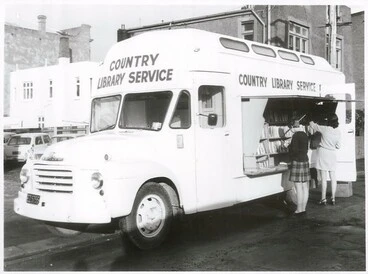
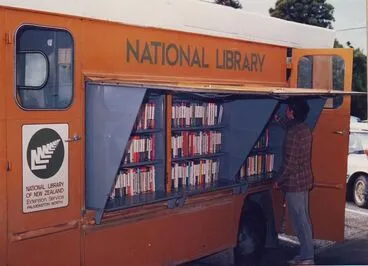


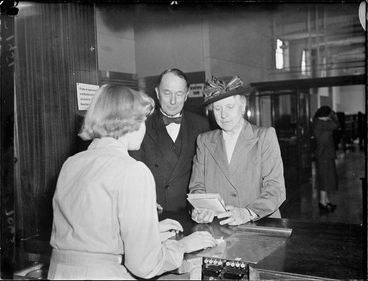



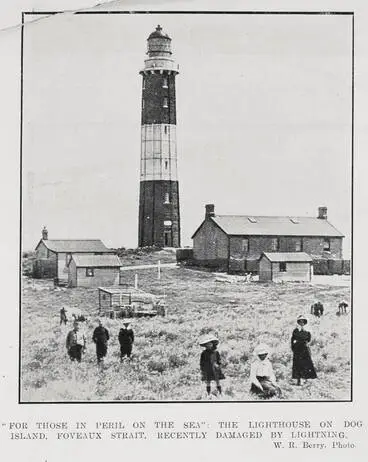
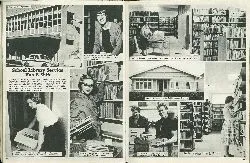




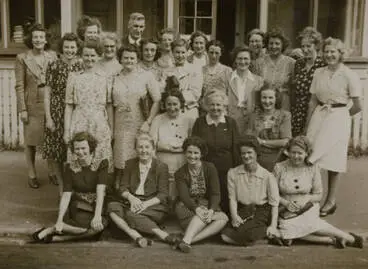



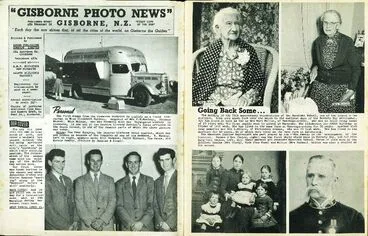
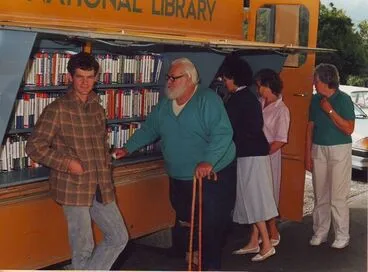

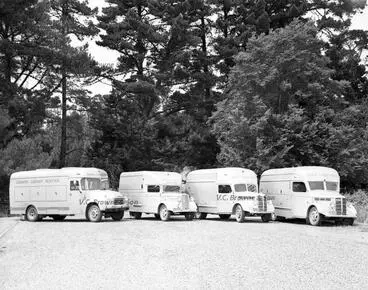
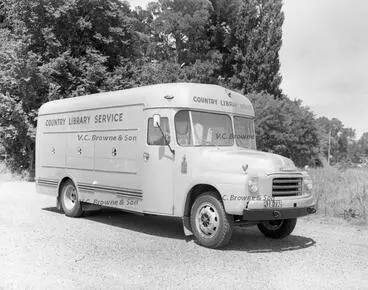
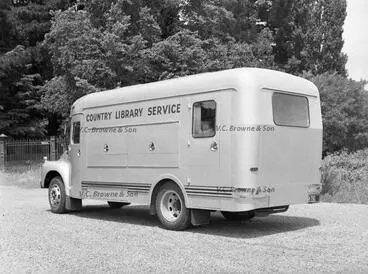
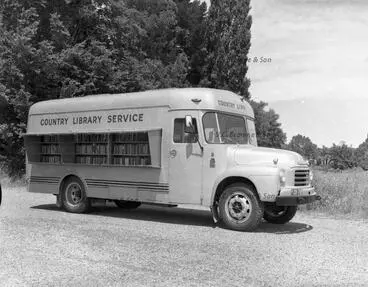
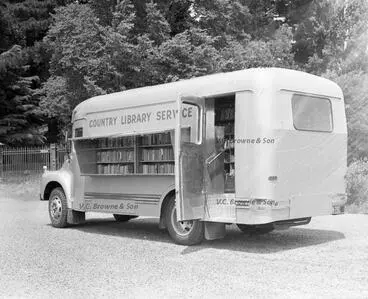
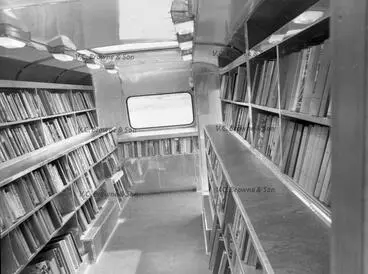
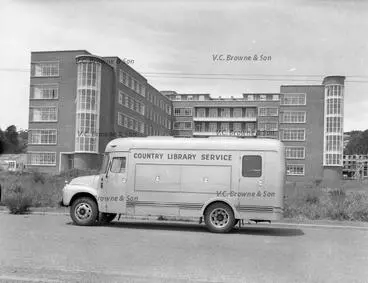

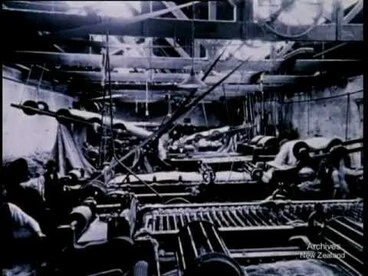




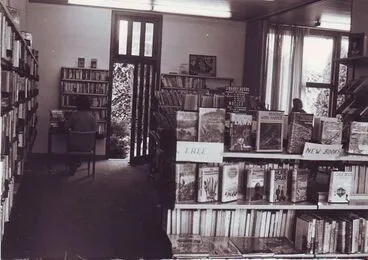
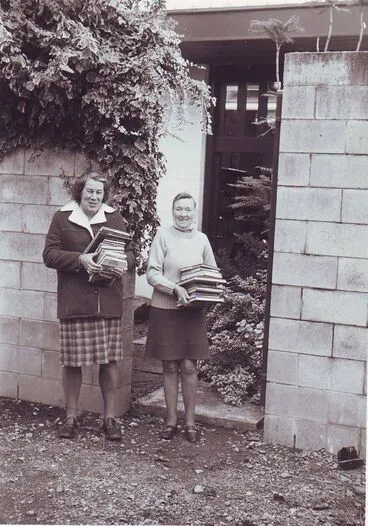

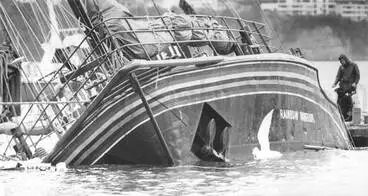

![[ClockTower - University of Auckland] Image: [ClockTower - University of Auckland]](https://thumbnailer.digitalnz.org/?resize=770x&src=https%3A%2F%2Fcollection-api.aucklandmuseum.com%2Frecords%2Fimages%2Fmedium%2F501106%2F351ce1a24c5d9aaebd8ee92b613d5c6e14822eae.jpg&resize=368%253E)
